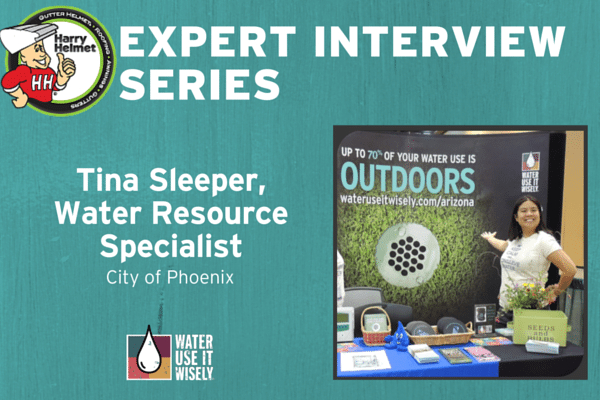Tina Sleeper, a Water Resource Specialist at the City of Phoenix and member of Water – Use It Wisely, explains, “My dream is that the urban water cycle becomes as well known as the natural water cycle.” Tina spoke with Harry Helmet recently about residential water conservation and why it’s so important.
What was your professional path that led to your work with Water – Use It Wisely?
I was an English teacher working at a high school and then developing curriculum for grades 6-12 for an online education company. My hobby was water conservation, and I got involved in non-profits that focused on permaculture and rainwater harvesting. Through an excellent opportunity, I was able to join the staff of Arizona Project WET, where I was able to integrate my passion for education and water. One year ago, I joined the Conservation and Efficiency Program here at the City of Phoenix Water Services Department. Because the City of Phoenix is a sponsor and member of Water – Use It Wisely, I am privileged to work with a great team to help guide its work.
What do you think most people don’t know about residential water conservation?
In my experience, many people do not know the sources of our water – in Phoenix, it’s the Colorado, Salt, and Verde Rivers, groundwater, and recycled water – and the process through which that water is treated and delivered straight to the tap. People often care about water in the abstract, but they often do not realize the role they play in the urban water cycle through the choices they make about how to use water. For example, here in Arizona, up to 70% of residential water use is outdoors, but many people do not know how much water their watering systems might be wasting.
Why is residential water conservation so important?
For many municipalities in the Valley, residential water demand is the largest demand for water. Water conservation at the residential level can make a big difference in reducing the amount of water used by a city, as well as prevent the need for new infrastructure (such as water treatment plants, wastewater treatment plants, miles of piping, etc.) as our population increases. In addition, every day residents also go to school, work in businesses, and run companies. Residents who understand and practice water conservation in the home can take these same principles and philosophies into the rest of the community.
I notice that you have a whole section for kids on your website. What are some simple things children can do to help the cause?
I believe kids are the leaders of our cause, but it takes an adult to engage them. Spending a few minutes to help your kids become more aware of everyday water use can be as simple as pointing out the water-using fixtures in a home.
The Tip Tank Game is another fun game that kids can play that features water-saving devices and fixtures in the guise of simple household products. Even reading or completing activity books with kids about water can be powerful.
Kids have so much to learn about reading, science, math, and history. Water is an excellent topic to teach a variety of subject matter because water management is one of the most interdisciplinary fields. From the science of hydrology to the engineering it takes to create a hydroelectric dam, water provides the “why” for learning many foundational concepts.
What have you learned about water conservation through your work that has surprised you?
I am most surprised and fascinated to learn all the intricacies of how water is managed. Every day, I learn something new. However, when it comes to water conservation in my own home, it took a great while before I was convinced not to wash my own dishes. Efficient dishwashers with the EPA Energy Star Label (when used appropriately) use less water than washing by hand. It felt more intuitive to wash by hand and save the electricity. However, it was also very difficult to rely on my own behavior to ensure the most efficient strategies when washing a large amount of dishes. Eventually, I put my faith in the research that showed dishwashers used water more efficiently.
This one example is also indicative of the overall importance of increasing efficiency. Often, people think that water conservation is all about behavior management, but behavior is difficult to change and keep up. If you purchase and install a water-efficient household item or fixture (like a toilet, shower head or washing machine) that has the EPA WaterSense Label, it saves water every time you use it. It’s that simple!
What are some of the greatest challenges we face with conserving water?
I think the greatest challenge is misinformation. People I talk to often times have attitudes that vary from unconcerned to panicked about our water supplies. It’s difficult to get to the nitty gritty of how to use water efficiently when people come with such different attitudes and have a lot of misunderstandings about water resources and water use.
For example, we still battle with misinformation about the quality of our tap water. Understanding more about where water comes from and how it’s managed can really help allay fears while also increasing a sense of personal responsibility. Yet, we cannot teach everyone everything in one interaction or one social media post or one ad. It’s a long-term process that takes a lot of education and awareness from multiple angles.
Is there anything else you’d like to tell our readers?
Remember, there are a number of ways to save water, and they all start with you!
This blog originally appeared on Harry Helmet, an eco-friendly home improvement product service provider and installer.


